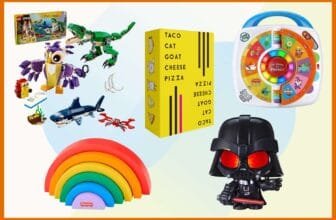
One of the earliest developmental milestones for babies is the ability to sit up, either with help or alone. As a new mother or caregiver, note that you can’t rush your child’s development, and babies eventually get the hang of sitting up by themselves. However, you can teach your baby to sit up by creating an encouraging environment and giving them the support they need.
In this post, you’ll learn the following:
Now, here we go…
When do Babies start to Sit Up By Themselves?
Babies begin sitting up without help at the age of 6 months. However, they may start sitting up with support and props at around 4 and 5 months when they have better head and neck control. During this time, you must support or hold the baby to prevent falling. Since every child is unique, you shouldn’t be alarmed if your baby sits up by themselves earlier or later than six months.
By the 7th month, some babies become comfortable sitting up from a laying down position. However, most babies may still require help to pull them up to the sitting position until they are about nine months, when they can confidently pull themselves up using their hands. Despite the varying development rates, your child should be able to sit up by the 7th month. In case of difficulties at this age, consider speaking to your baby’s physician.
Most preterm babies achieve the sitting milestone a month or two later than their counterparts. Speaking to your physician will give you an accurate estimate of the baby’s developmental milestones based on their unique condition. As your baby’s muscles strengthen and they get used to the idea of sitting up, they can sit up for longer hours.
How to Tell if Your Baby Is Ready to Sit Up
You can establish when your baby is ready to sit by observing them. Knowing the signs helps you prepare adequately on how to teach a baby to sit up and support them. Here are some of the signs that will tell you when your baby is ready to sit up.
(i) Head and Neck Stability
When you notice the baby can support their head when you pick them up, your child is ready to sit up. Usually, the stability is evidence of enough strength that babies need to start sitting up.
(ii) Core Strength
You can start teaching your baby to sit up by themselves once you notice they have adequate core strength. If your child doesn’t fall over forward and keeps their back straight while seated in the tripod pose, they are ready to sit up on their own.
(iii) Pushing Themselves When Lying Down
A baby who is ready to sit up will start pushing themselves upwards while lying facing downwards. By this time, the baby will also have learned how to roll over.
(iv) Sitting for Short Periods
When your baby is ready to sit up, they may start sitting for short periods when you put them in an upright position. Before you can start teaching babies to sit up, ensure that you support them when they attempt sitting up on their own as they can fall over.
(v) Rolling over on Both Direction and the Tripod Sit.
A baby who is ready to sit up by themselves will be able to roll over in both directions. Also, your baby may attempt the tripod position where they sit while supporting them using one or both hands on the floor.
When you notice the above readiness signs, you should start exploring ideas on how to teach a baby to sit up. Always keep your child under supervision and create a safe environment for them to practice.
5 Simple Activities to Teach Your Baby to Sit Up
Once you are sure your baby is ready to sit up, you can encourage them using simple activities. Here are some simple activities you should consider to teach your baby to sit up.
1. Tummy Time
Tummy time is one of the best ways to teach a baby to sit up. It strengthens a baby’s back muscles which are necessary for support when sitting up on their own. Also, when babies are on their bellies, they lift their heads to look around. Doing so develops their neck strength, as well as upper body. You can start tummy time as early as a few weeks after birth by doing it a few minutes every day.
2. Back Time
The time your baby spends on her back helps develop her front body muscles. You can encourage back time by dangling toys over your baby for them to reach out. Doing so engages the baby’s flexors on the chest and upper trunk.
3. Play with Toys
Playing with toys can act as an incentive when teaching babies to sit up. Simply hold the toy in front of the child and let them reach out to it while sitting. You can also place the toy at the baby’s feet and raise it to their eye level for them to reach out. The baby may also be able to maintain the sitting position while playing with the toys.
4. Help Your Baby Up
Once your baby is 4 or 5 months old, you can practice helping them up into a sitting position. Do this by holding the baby’s hands and pulling them towards you. Besides being a fun activity, it familiarizes your child with the necessary movements for sitting up.
Ensure you provide cushioning or keep your hands around the baby to prevent falling. Once they are strong enough, babies can sit up by themselves, and you can let them go once they are in a sitting position.
5. Prop the Baby
You can have your baby sit upright on your lap, stroller, or infant seat while supporting the baby’s head with pillows or your hands. Your baby learns to maintain balance while seated in these positions. However, it is not advisable to prop your baby in a stroller or car seat as it may inhibit their movements. Always opt for strollers or car seats that can recline.
Final Thoughts about Helping a Baby to Sit Up
Now you know how to teach a baby to sit up, but do remember to practice patience as every child is unique and might develops differently. Also, be consistent and allow your child to practice as much as possible as it helps them strengthen their muscles and build confidence. The more your baby tries to sit up on their own, the more strength and balance they attain.
Sources: Help Me Grow, Baby Milestones – When Babies Sit Up, Roll Over and Crawl, 2010, Healthy Children, Movement Milestones: Babies 4 to 7 Months, March 2024, Centers for Disease Control and Prevention, Milestone Moments, 2009, and Kid’s Health, Movement, Coordination, and Your 4- to 7-Month-Old, June 2019.






